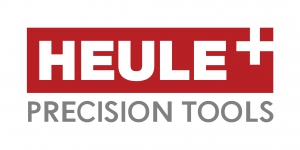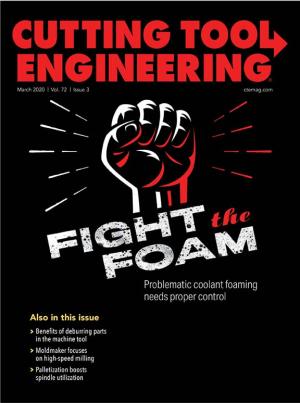Just as holemaking is common in metalworking, so is deburring the tops and bottoms of produced holes. Chamfering tools are effective, as are the familiar Rotoburr-style scraper blades. These tools also deburr machined edges fairly well and, given the right extension or blade geometry, can access hard-to-reach areas deep inside parts. Add a few Scotch-Brite pads, a drill press and a bench grinder to the mix, and there’s little that any skilled machine operator can’t deburr.
However, these traditional deburring methods are slow. Features that can’t be reached while in a machine — which is often much of a part — must be manually scraped, buffed and chamfered. If an operator isn’t paying attention, a machine tool might sit idly while he or she is busy deburring parts. And a bit too much pressure with a grinding wheel or blade could mean the inadvertent scrapping of a completed, possibly very expensive machined component.
Worker health and safety are also a consideration. As machinists would attest, cuts, scrapes and repetitive stress injuries are common during manual deburring, never mind the potential inhalation of abrasive grit. Surely safer, more productive methods are available?
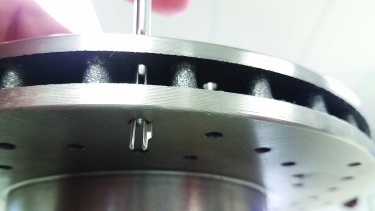
The ability to deburr both sides of a hole (above) in a single operation is a huge timesaver. Image courtesy of Whitney Tool
Two for One
“You don’t want to pay CNC machinists to deburr holes,” said Samuel Dean, director of sales and marketing at Whitney Tool Co. Inc., Bedford, Indiana. “You want to pay them to program and set up and maintain machinery, which means that the deburring — or as much of it as possible — is done inside the machining center where consistency is assured and there’s no chance of missing a hole. This is why it’s so important to convert manual deburring operations into automated ones so that shops can more efficiently utilize their production floor staff.”
One step in this conversion process is the use of Burr-Zit and Handi-Burr deburring systems from Whitney Tool, he said. Often referred to as clothespin tools, Burr-Zit deburrs the front and back of hole diameters from 1.98 mm to 25.4 mm (0.078" to 1") in a single in-and-out pass. The Handi-Burr line of spring-loaded deburring tools extends that diameter range to 50.8 mm (2"). Multiple lengths, geometries and coatings are available, and the Burr-Zit series can be purchased in kit form to cover a range of hole sizes.
Dean said Handi-Burr typically is reserved for manual deburring operations in a drill press or power tool while Burr-Zit is suitable for CNC and manual equipment. He also said both tool types are only for deburring, in that they produce a rounded edge. If a qualified, dimensionally accurate chamfer is needed, it should be machined using an actual milling cutter.
Deburring in a Snap
Matt Baumet, technical sales engineer at Heule Tool Corp., Loveland, Ohio, suggested several similar alternatives. The company’s Snap front and back chamfering tools, for example, feature a replaceable, spring-loaded blade and are intended for use with CNC machine tools while providing more accurate chamfering than tools for only
deburring.
“It depends on the hole size and material,” he said, “but you could expect to hold plus or minus a couple thousandths on a chamfer.”
Also available are the Cofa “universal deburring tool” for elliptical or contoured surfaces, the Defa adjustable chamfering tool and the X versions of Snap and Cofa for deburring cross-holes and intersecting bores.
“The Cofa and Cofa-X are specifically designed for irregular surfaces,” Baumet said. “Let’s say you’re deburring a hole drilled on an angled surface or a cross-hole in a piece of tubing. Here, the blade actually pivots in and out of the holder for continuous engagement. You get a nice, even chamfer all around the hole instead of the football shape you’d see using a standard chamfer tool.”
Here again, multiple grades, geometries, diameters and lengths are offered, and both companies provide application and programming advice to those getting started. While Dean and Baumet might not agree on which brand of deburring tools a shop should buy, they do agree that deburring is a machining process that bears lots of low-hanging fruit.
“There are still an awful lot of people out there doing it by hand,” Baumet said. “Sometimes it’s because that’s all they know, other times because they don’t want to spend the money on a dedicated deburring tool. Either way, there’s plenty of room for improvement.”
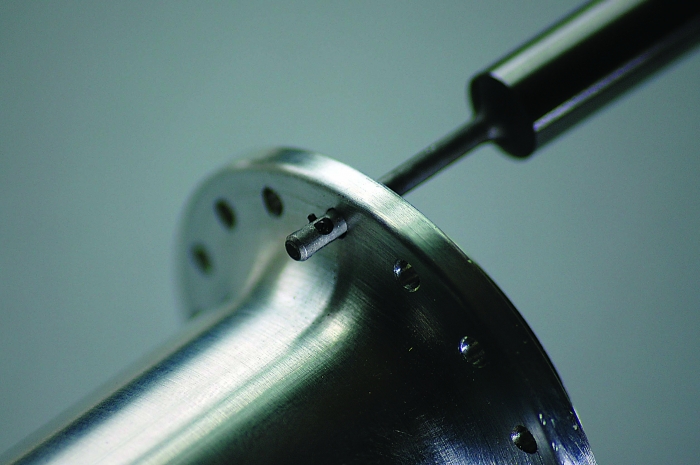
Using an automated deburring tool like the Cofa, tedious deburring of small parts by hand can be eliminated for maximum efficiency and burr-free parts. Image courtesy of Heule Tool
True Grit
That covers hole deburring, but what about smoothing the sharp, often ragged edges found on pockets, bosses, ribs and other machined features? Mike Shappell, senior application engineer at Norton | Saint-Gobain Abrasives, Worcester, Massachusetts, said programming the toolpaths needed for a chamfer mill or radius cutter isn’t terribly difficult, eliminating some if not all manual deburring. What’s more, some shops are morphing those toolpaths for use with one of the company’s nonwoven, unified or convolute abrasive wheels.
“The wheels wear well, are coolant-proof, and most CNC machine tools these days have some level of cutting fluid filtration, lowering concerns over grit and contaminants getting into the way surfaces,” he said. “So with that in mind, it’s not a huge leap to mount a nonwoven wheel in a CNC machining center and use it for part deburring and finishing operations. Whether you’re using these products in an automated environment or a manual one, however, I strongly advise that shops review their abrasive wheel and disc selections every few years because we’re constantly improving both.”
Let R2-D2 Do It
David Suica offers a novel though unsurprising approach to deburring, one that often trumps in-machine and manual processes alike. The president of automation systems provider Fastems LLC, West Chester, Ohio, said the company’s self-contained robotized finishing cell comes equipped with an industrial robot and gripper system, an automatic toolchanger and a servo-powered rotary workholding table and can have electric or pneumatic spindles. The RFC is easy enough to set up that it’s suitable for low-volume, high-mix work.
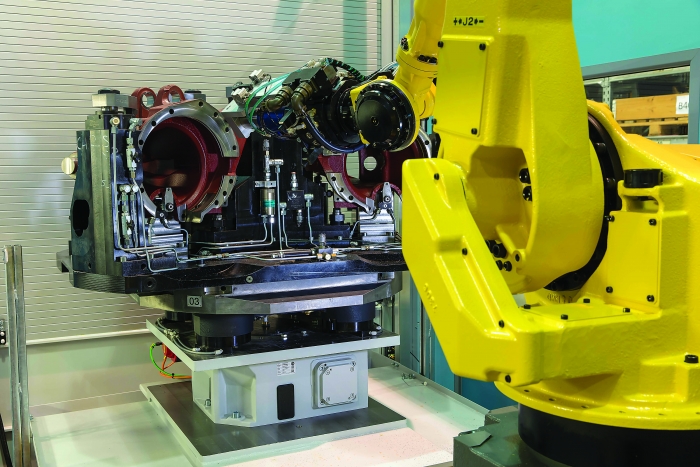
This self-contained robotized finishing cell boasts an industrial robot and gripper system and is suitable even for low-volume, high-mix work. Image courtesy of Fastems
“The ease of setup is largely due to our Fastsimu programming and simulation software,” he said. “It allows you to import the CAD model and generate the toolpaths, the inspection points, check for collisions — all offline. There’s no more standing on the shop floor with a teach controller nudging the head this way and that or trying to figure out how much wheel pressure to apply. And because there’s a toolchanger and the option for a tool magazine, you can easily switch to whatever deburring tool or abrasive wheel is most appropriate for the application. There are very few parts that the RFC can’t complete in a single deburring operation, with changeover often taking just a few minutes.”
Although relatively new, such systems are becoming popular, Suica said. As alluded to earlier, automated deburring raises fewer health and safety issues than manual deburring. Part quality is similarly improved, with no worries over an expensive machine tool sitting idly while the operator tends to a drill press or buffing wheel. And because the robot acts as a hardworking assistant to the CNC machine tool — or flexible manufacturing system — more machine uptime is possible.
“Considering the difficulty that everyone faces in finding qualified people,” he said, “plus the call for unattended machining in an environment that’s increasingly demanding, the need for this level of automated deburring is clear.”
Burning Burrs
Imagine a process that can completely deburr a part in less time than it took to read this sentence — much less time. The thermal energy method removes burrs, flashing and trapped particles from practically any workpiece in just a few milliseconds. TEM works by placing a workpiece — or hundreds of workpieces — in a sealed, pressurized chamber, filling it with a mixture of methane gas and oxygen and then introducing a spark. The resultant explosion generates a 3,316° C (6,000° F) heat wave that instantaneously vaporizes burrs and loose matter but leaves the workpiece undamaged.
Bruno Boutantin, global marketing director for Extrude Hone LLC, Irwin, Pennsylvania, said suitable TEM applications include die castings and machined parts of all shapes and sizes, but the approach is popular in the heavy equipment industry. This popularity is due to TEM’s fast cycle times, consistency and cost-effectiveness. The method is often ideal for deburring manifolds and other large, high-volume components.
Extrude Hone also offers abrasive flow machining and electrochemical machining, he said.
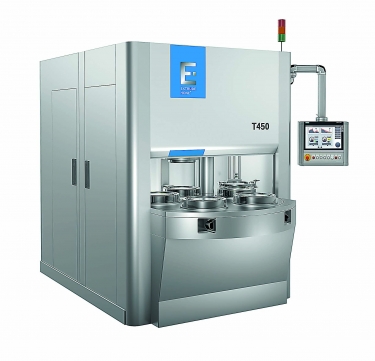
The T350 and T450 (pictured) thermal deburring machines offer a fast, cost-effective way to remove burrs and loose material. Image courtesy of Extrude Hone
“AFM uses a puttylike abrasive media that is forced under pressure through or around a workpiece, removing burrs and smoothing surfaces as it passes,” Boutantin said, “while ECM employs a shaped cathode and electrolytic fluid to quickly erode even stubborn burrs.”
Both processes are scalable, accommodating large parts, such as crankshafts, and relatively small parts, such as turbine blades and fuel nozzles.
“They’re also scalable in the sense that we have customers with multimillion-dollar equipment installations to those with fewer than 20 employees who process lot sizes of 400 to 1,000 pieces per production run,” Boutantin said. “Between TEM, AFM, ECM and their variants, we have solutions for practically any deburring need.”
— Kip Hanson
For more information about Extrude Hone, call 800-367-1109 or visit www.extrudehone.com.
Contact Details
Contact Details
Contact Details
Contact Details
Related Glossary Terms
- abrasive
abrasive
Substance used for grinding, honing, lapping, superfinishing and polishing. Examples include garnet, emery, corundum, silicon carbide, cubic boron nitride and diamond in various grit sizes.
- abrasive flow machining
abrasive flow machining
Finishing and deburring operation for holes, inaccessible areas or restricted passages. Done by clamping the workpiece in a fixture, then extruding semisolid abrasive media through the passage. Often, multiple parts are loaded into a single fixture and finished simultaneously.
- automatic toolchanger
automatic toolchanger
Mechanism typically included in a machining center that, on the appropriate command, removes one cutting tool from the spindle nose and replaces it with another. The changer restores the used tool to the magazine and selects and withdraws the next desired tool from the storage magazine. The changer is controlled by a set of prerecorded/predetermined instructions associated with the part(s) to be produced.
- buffing
buffing
Use of rapidly spinning wires or fibers to effectively and economically remove burrs, scratches and similar mechanical imperfections from precision and highly stressed components. The greatest application is in the manufacture of gears and bearing races where the removal of sharp edges and stress risers by power methods has increased the speed of the operation.
- burning
burning
Rotary tool that removes hard or soft materials similar to a rotary file. A bur’s teeth, or flutes, have a negative rake.
- chamfering
chamfering
Machining a bevel on a workpiece or tool; improves a tool’s entrance into the cut.
- chamfering tool
chamfering tool
Cutter or wheel that creates a beveled edge on a tool or workpiece.
- computer numerical control ( CNC)
computer numerical control ( CNC)
Microprocessor-based controller dedicated to a machine tool that permits the creation or modification of parts. Programmed numerical control activates the machine’s servos and spindle drives and controls the various machining operations. See DNC, direct numerical control; NC, numerical control.
- computer-aided design ( CAD)
computer-aided design ( CAD)
Product-design functions performed with the help of computers and special software.
- cutting fluid
cutting fluid
Liquid used to improve workpiece machinability, enhance tool life, flush out chips and machining debris, and cool the workpiece and tool. Three basic types are: straight oils; soluble oils, which emulsify in water; and synthetic fluids, which are water-based chemical solutions having no oil. See coolant; semisynthetic cutting fluid; soluble-oil cutting fluid; synthetic cutting fluid.
- drilling machine ( drill press)
drilling machine ( drill press)
Machine designed to rotate end-cutting tools. Can also be used for reaming, tapping, countersinking, counterboring, spotfacing and boring.
- electrochemical machining ( ECM)
electrochemical machining ( ECM)
Operation in which electrical current flows between a workpiece and conductive tool through an electrolyte. Initiates a chemical reaction that dissolves metal from the workpiece at a controlled rate. Unlike with traditional cutting methods, workpiece hardness is not a factor, making ECM suitable for difficult-to-machine materials. Takes such forms as electrochemical grinding, electrochemical honing and electrochemical turning.
- electrochemical machining ( ECM)2
electrochemical machining ( ECM)
Operation in which electrical current flows between a workpiece and conductive tool through an electrolyte. Initiates a chemical reaction that dissolves metal from the workpiece at a controlled rate. Unlike with traditional cutting methods, workpiece hardness is not a factor, making ECM suitable for difficult-to-machine materials. Takes such forms as electrochemical grinding, electrochemical honing and electrochemical turning.
- flexible manufacturing system ( FMS)
flexible manufacturing system ( FMS)
Automated manufacturing system designed to machine a variety of similar parts. System is designed to minimize production changeover time. Computers link machine tools with the workhandling system and peripherals. Also associated with machine tools grouped in cells for efficient production. See cell manufacturing.
- gang cutting ( milling)
gang cutting ( milling)
Machining with several cutters mounted on a single arbor, generally for simultaneous cutting.
- grinding
grinding
Machining operation in which material is removed from the workpiece by a powered abrasive wheel, stone, belt, paste, sheet, compound, slurry, etc. Takes various forms: surface grinding (creates flat and/or squared surfaces); cylindrical grinding (for external cylindrical and tapered shapes, fillets, undercuts, etc.); centerless grinding; chamfering; thread and form grinding; tool and cutter grinding; offhand grinding; lapping and polishing (grinding with extremely fine grits to create ultrasmooth surfaces); honing; and disc grinding.
- grinding wheel
grinding wheel
Wheel formed from abrasive material mixed in a suitable matrix. Takes a variety of shapes but falls into two basic categories: one that cuts on its periphery, as in reciprocating grinding, and one that cuts on its side or face, as in tool and cutter grinding.
- industrial robot
industrial robot
Robot designed for industrial use. Primarily used as a material-handling device but also used for changing tools, assembling parts, and manipulating special tools and measuring devices. Depending on design, an industrial robot can be programmed to perform a task by means of a controller, or it can be “walked” through the required movements by utilizing a digitizing system that translates movements into commands that the robot can be “taught.” See robot; teaching pendant.
- machining center
machining center
CNC machine tool capable of drilling, reaming, tapping, milling and boring. Normally comes with an automatic toolchanger. See automatic toolchanger.
- metalworking
metalworking
Any manufacturing process in which metal is processed or machined such that the workpiece is given a new shape. Broadly defined, the term includes processes such as design and layout, heat-treating, material handling and inspection.
- milling
milling
Machining operation in which metal or other material is removed by applying power to a rotating cutter. In vertical milling, the cutting tool is mounted vertically on the spindle. In horizontal milling, the cutting tool is mounted horizontally, either directly on the spindle or on an arbor. Horizontal milling is further broken down into conventional milling, where the cutter rotates opposite the direction of feed, or “up” into the workpiece; and climb milling, where the cutter rotates in the direction of feed, or “down” into the workpiece. Milling operations include plane or surface milling, endmilling, facemilling, angle milling, form milling and profiling.
- milling cutter
milling cutter
Loosely, any milling tool. Horizontal cutters take the form of plain milling cutters, plain spiral-tooth cutters, helical cutters, side-milling cutters, staggered-tooth side-milling cutters, facemilling cutters, angular cutters, double-angle cutters, convex and concave form-milling cutters, straddle-sprocket cutters, spur-gear cutters, corner-rounding cutters and slitting saws. Vertical cutters use shank-mounted cutting tools, including endmills, T-slot cutters, Woodruff keyseat cutters and dovetail cutters; these may also be used on horizontal mills. See milling.
- milling machine ( mill)
milling machine ( mill)
Runs endmills and arbor-mounted milling cutters. Features include a head with a spindle that drives the cutters; a column, knee and table that provide motion in the three Cartesian axes; and a base that supports the components and houses the cutting-fluid pump and reservoir. The work is mounted on the table and fed into the rotating cutter or endmill to accomplish the milling steps; vertical milling machines also feed endmills into the work by means of a spindle-mounted quill. Models range from small manual machines to big bed-type and duplex mills. All take one of three basic forms: vertical, horizontal or convertible horizontal/vertical. Vertical machines may be knee-type (the table is mounted on a knee that can be elevated) or bed-type (the table is securely supported and only moves horizontally). In general, horizontal machines are bigger and more powerful, while vertical machines are lighter but more versatile and easier to set up and operate.
- toolchanger
toolchanger
Carriage or drum attached to a machining center that holds tools until needed; when a tool is needed, the toolchanger inserts the tool into the machine spindle. See automatic toolchanger.
Contributors
Fastems LLC
513-779-4614
www.fastems.com
Heule Tool Corp.
513-860-9900
www.heuletool.com
Norton | Saint-Gobain Abrasives
508-795-5000
www.nortonabrasives.com
Whitney Tool Co. Inc.
812-275-4491
www.whitneytool.com

